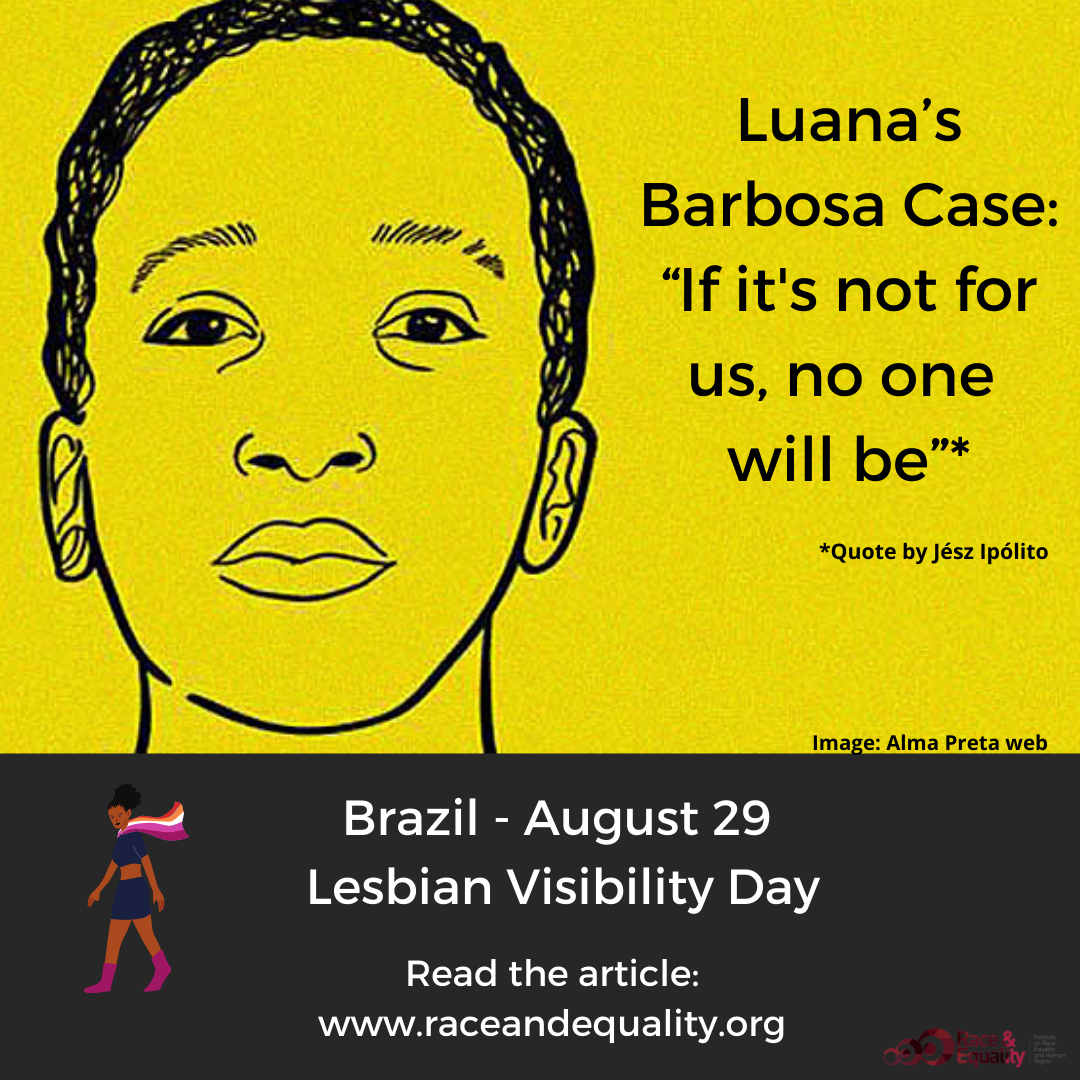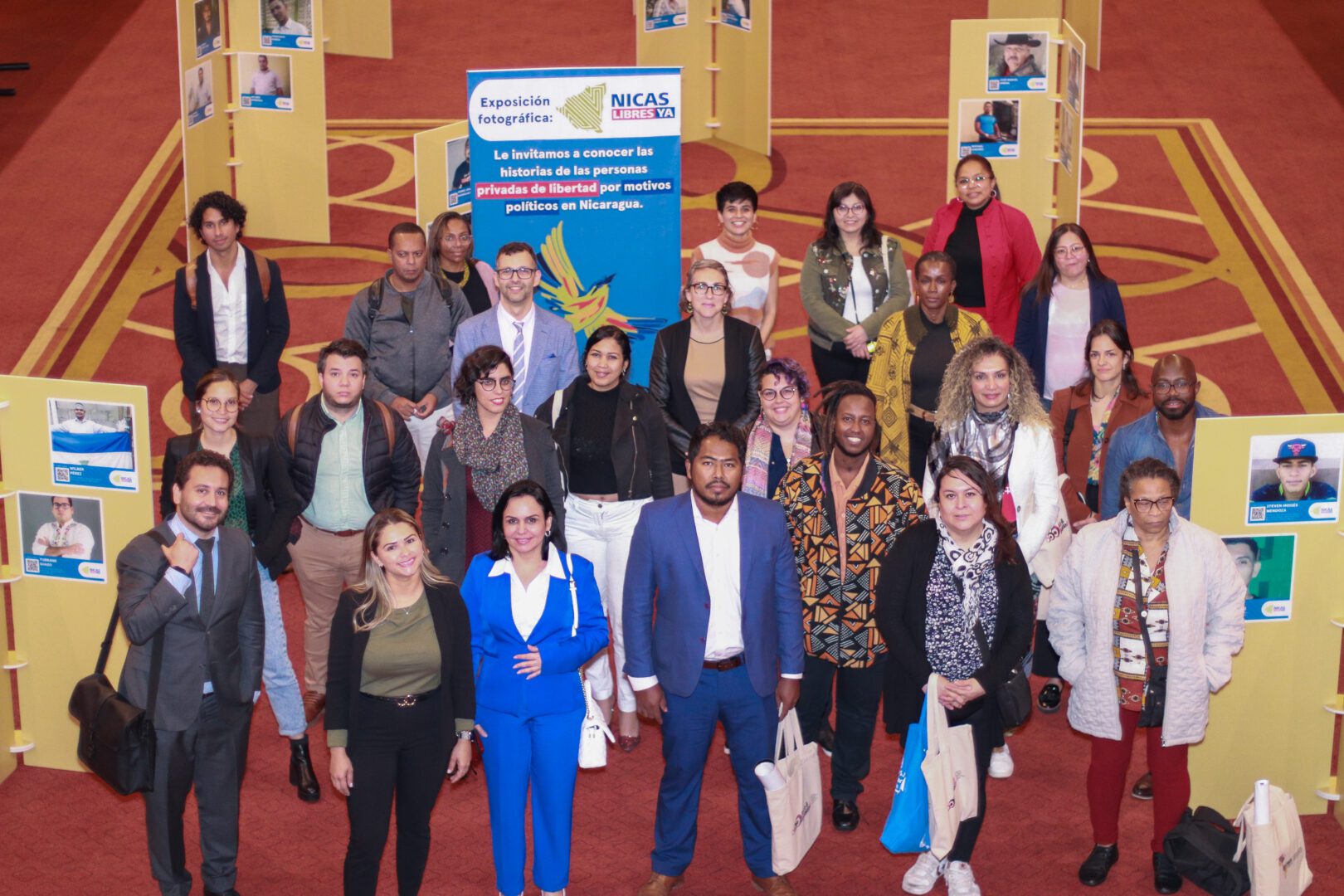Lesbian Visibility Day in Brazil: Luana Barbosa Case – “If not for us, no one will be”*
Brazil, August 29, 2021 – The month of August in Brazil highlights and marks the struggles of lesbian women. It’s a month that honors Lesbian Pride— August 19 specifically references the […]

Brazil, August 29, 2021 – The month of August in Brazil highlights and marks the struggles of lesbian women. It’s a month that honors Lesbian Pride— August 19 specifically references the first manifestation of lesbian women, known as the “Brazilian Stonewall,” in São Paulo, in 1983. Banned from distributing the bulletin, “Chanacomchana,” Brazil’s first lesbian activist publication, the activists decided to occupy Ferro’s Bar’ claiming their rights and denouncing lesbophobia. August 29 also calls for the right to freedom of expression and representation as it represents Lesbian Visibility Day. It was during the first National Lesbian Seminar (Senale) held in Rio de Janeiro, in 1996, that the date was created to denounce the erasure and highlight lesbian experiences within the LGBTI+ and feminist movement.
To stress the importance of ‘Lesbian Visibility,’ Race and Equality brings to the surface the Luana Barbosa Case, which completes five years this year. The murder of 34-year-old Luana Barbosa dos Reis Santos, in 2016, in Ribeirão Preto (SP), denotes the complete invisibility black lesbian women endure, the absence of their social and individual rights, and moreover it symbolizes why lesbians need to claim a fight for visibility, rights and integral security.
Luana was the victim of brutal police violence. After being approached by three military police officers, she refused to be searched and demanded the presence of a female police officer. In the company of her son, mother and neighbors, Luana was brutally beaten by the police and as a result died five days after the attack due to cerebral ischemia and brain trauma. The brutality of her death reveals the intricacies of police actions in Brazil towards black LGBTI+ people, who, in addition to possessing a color that equates to the public enemy for the police, Luana’s existence challenges the cis-heteronormativity, further aggravating police brutality. After Luana’s experience with police brutality, she still managed to record a video in which she reported the assaults, in addition to the death threats made by police officers who also threatened her family [1].
In February 2020, Luana’s case was ordered by the courts so that the defendants would be tried by the popular jury. However, the defense appealed and the trial continues without a definite date. Although the trial was suspended, the case of Luana Barbosa was not labeled as a mere allegory of police violence in Brazil. Immediately after the incident, the UN Women and the UN High Commissioner for Human Rights of South America (OHCHR) appealed to the Brazilian State for an impartial and transparent investigation recognizing that the case of Luana is emblematic of racist violence, gender and lesbophobic in Brazil [2].
According to Roseli Barbosa, the sister of the victim, the fact that Luana associates with masculine lesbianism, which in Brazil is accompanied by the adjectives: ‘sapatão’ and ‘camioneira’ in a pejorative way (words that were re-signified by the lesbian movements with pride and belonging), constantly made Luana the target of insults and prejudice. Several times, Luana paid a high price for looking like a poor, black man [3]. In another police interrogation, Luana had to show her breasts to prove she was a woman. The presumption of innocence for black, poor and vulnerable people is practically non-existent. To exist as a black-lesbian, woman-mother-peripheral is a cry of resistance in Brazil.
What is the color of the Invisible?
Race and Equality continues to follow the case of Luana Barbosa with Brazilian LGBTI+ organizations and denounce it to international human rights mechanisms. In the dossier “What is the color of the Invisible? The human rights situation of the black LGBTI population in Brazil” [4], published by Race and Equality, there is a chapter dedicated to denouncing police violence against black LGBTI people in the country. In focus groups carried out by civil society organizations, it can be seen that the brutal death of a black woman did not mobilize society and that lesbian invisibility is a determining factor in the lack of public commotion regarding the deaths caused by the State.
As the dossier points out, socio-racial hierarchies in Brazil determine the conditions of life and death. There is a hierarchy between death that is visible and death that is not, and skin color is a factor that separates the two. Fátima Lima, a black lesbian woman and university professor, argues that the life and death of lesbian women are marked by erasure.
“The violence suffered by black and racialized women in the context of the South is still very little visible, discussed and faced. Marked by silence and pain, their stories are crossed by different forms of violence that range from injurious discursive practices to corrective rape, beatings and murders. In the Brazilian LGBTI+ movement, for example, lesbian women have always denounced their deletion,” expresses Fátima. [5]
2021: Building new directions for the case of Luana Barbosa
In 2021, the case of Luana Barbosa continued to have international repercussions during the 47th Assembly of the United Nations High Commissioner for Human Rights (OHCHR), in which Michelle Bachelet, UN High Commissioner for Human Rights, presented the report on systemic racism and the excessive use of public force [6]. The tragic story of Luana’s murder was recorded in the report as one of seven cases in the world where police violence was linked directly to racial discrimination and prejudice. According to Bachelet, “there is a widespread presumption of guilt over black people,” and adds that “the excessive vigilance imposed on black people makes them feel threatened rather than protected.”
During that same Assembly (UNHRC47), Race and Equality denounced police and political violence against LGBTI+ people in Brazil as a result of systemic racism. Together with the International Lesbian, Gay, Bisexual, Trans and Intersex Association (ILGA Mundo), they joined the pronouncement of the Brazilian Association of Lesbians, Gays, Bisexuals, Transvestites, Transsexuals and Intersex (ABGLT). It should be noted that the case of Luana Barbosa was present in the joint statement, to further foster an international repercussion of justice for Luana Barbosa [7].
Nationally, there is a political movement to fight against lesbocide and for LGBTI+ agendas. During the last municipal election, in 2020, several black, lesbian and transgender parliamentarians were elected, however before and during the electoral process they faced numerous threats and hate speech for their expressions of gender and sexual orientation. During their terms of office, these parliamentarians strategically united to confront and denounce the ongoing political violence in Brazil.
Mônica Francisco, State Deputy of Rio de Janeiro (PSOL), is the author of the ‘Luana Barbosa Draft Law.’ The bill aims to establish April 13 (date of Luana’s murder) as the ‘State Day to Combat Lesbocide.’ In addition to making visible and promoting the rights of lesbian women, the date is intended to support public campaigns and activities aimed at raising public awareness of a culture of non-violence against lesbian women. The bill, which still needs to be voted on and approved by the Legislative Assembly of Rio de Janeiro, represents a major step towards the construction of a public agenda that supports and makes visible the protection and integral health of lesbian women.
Among the circumstances that made Luana Barbosa’s case a symbol of the struggle and resistance of lesbian women in Brazil, Race and Equality understands that the lack of public authority assistance for the specificities of lesbian women is one of the key factors for their agenda’s erasure. The absence of public data on lesbocide and on the current situation of living lesbians leaves civil society with the responsibility of research production which does not always have the necessary financial support to be carried out.
In Rio de Janeiro, in 2020, the Collective Resistance Lesbian da Maré launched a mapping of lesbian and bisexual women living in favelas [8]. The document aims to denounce the scarcity of answers about lesbian experiences in favelas, especially experiences of non-violence, since the hegemonic representations of favelas refer to violence and the abandonment of public power. Also, the Associação Lesbofeminista Coturno de Vênus, headquartered in Brasília, launched, in 2020, a mapping of lesbians in the Federal District. This year, Coturno de Vênus is promoting a nationwide mapping of lesbians, together with the Brazilian Lesbian League. It will be the first national socio-demographic mapping of lesbians.
Race and Equality recognizes that there is still a long way for lesbian women to reach the fullness of their rights. It is essential to create public policies that deconstruct a collective imaginary beyond violence, pain and hypersexualization of lesbian women. Violence in life, through corrective rapes, family abandonment, conversion therapies, loss of custody of their children, lead many lesbian women to suicide. Thus, Race and Equality recommends to the Brazilian State to:
1 – Create a Legal and Parliamentary Committee to produce data on violence against lesbian women – lesbocide (lesbocídio);
2 – Promote public policies that support and strengthen organizations that seek to make lesbian agendas visible;
3 – Implement a policy of comprehensive protection for lesbian women who are victims of violence, in light of the intersectional issues raised in Luana Barbosa’s case;
4- Promote actions and campaigns to combat lesbophobia to eradicate disinformation and prejudice that reproduce the marginalization of lesbian women;
5 – Implement a national health policy that meets the specificities of the LGBTI population, in this case, specifically meeting the demands of the lesbian population.
*Quote by Jész Ipólito in his article published in: https://www.geledes.org.br/do-luto-luta-nao-esqueceremos-luana-barbosa-dos-reis-morta-por-pms-em-ribeirao-preto/
[4] and [5] http://oldrace.wp/wp-content/uploads/2020/11/FINAL_dossie-lgbti-brasil-ebook.pdf
[6]https://www.ohchr.org/SP/NewsEvents/Pages/DisplayNews.aspx?NewsID=27218&LangID=S
[7] http://oldrace.wp/es/onu/raca-e-igualdade-celebra-a-adocao-da-onu/
[8] https://bit.ly/2TDB5ES and http://oldrace.wp/es/brazil-es/coletiva-resistencia-lesbica-realiza-mapeamento/
[9] https://bit.ly/lesbocenso and http://oldrace.wp/es/brazil-es/coturno-de-venus-realiza-lesbocenso/

